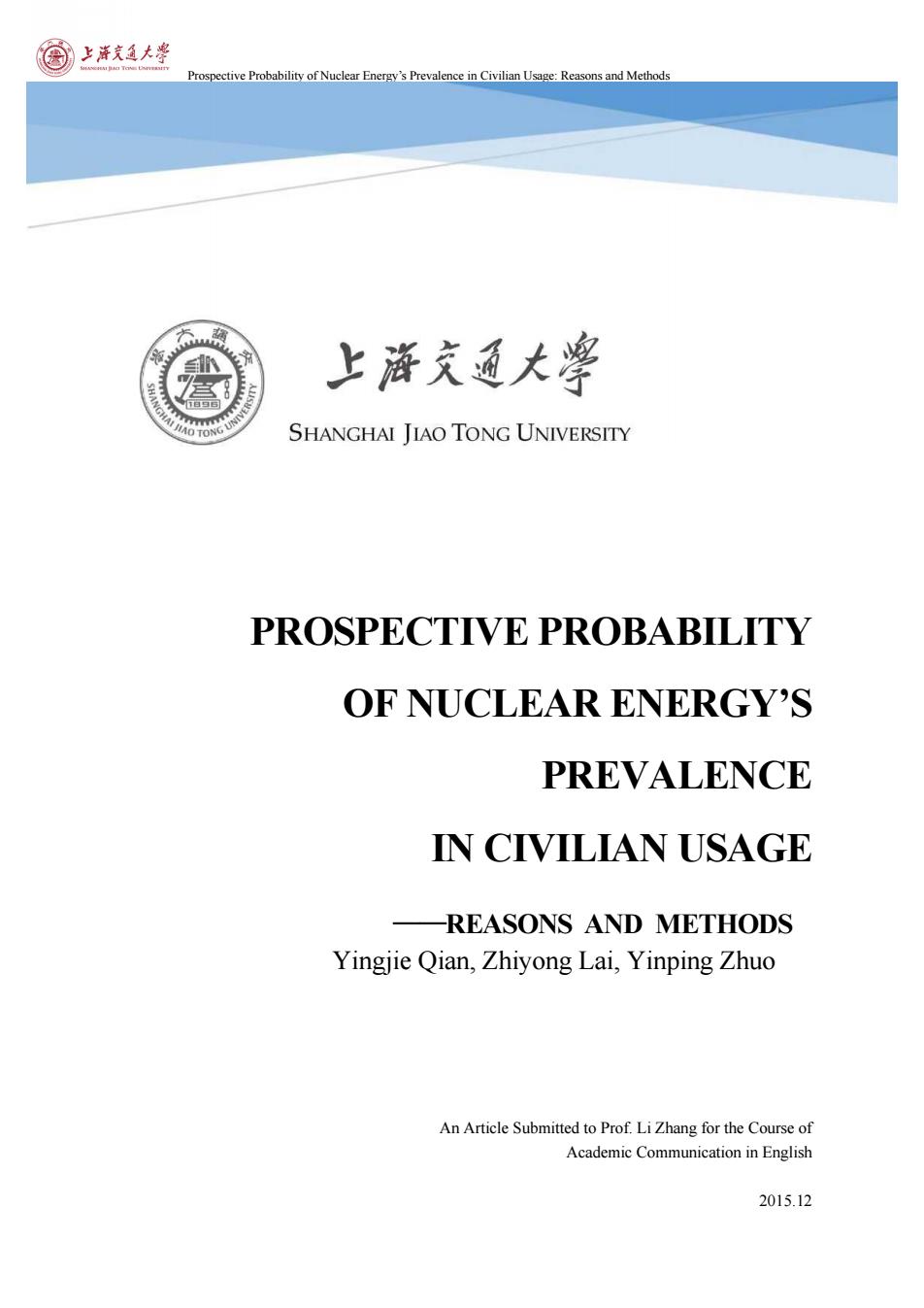
上游充通大粤 Prospective Probability of Nuclear Energy's Prevalence in Civilian Usage:Reasons and Methods 的 上游充通大睾 O TONG SHANGHAI JIAO TONG UNIVERSITY PROSPECTIVE PROBABILITY OF NUCLEAR ENERGY'S PREVALENCE IN CIVILIAN USAGE REASONS AND METHODS Yingjie Qian,Zhiyong Lai,Yinping Zhuo An Article Submitted to Prof.Li Zhang for the Course of Academic Communication in English 2015.12
Prospective Probability of Nuclear Energy’s Prevalence in Civilian Usage: Reasons and Methods PROSPECTIVE PROBABILITY OF NUCLEAR ENERGY’S PREVALENCE IN CIVILIAN USAGE ——REASONS AND METHODS Yingjie Qian, Zhiyong Lai, Yinping Zhuo An Article Submitted to Prof. Li Zhang for the Course of Academic Communication in English 2015.12
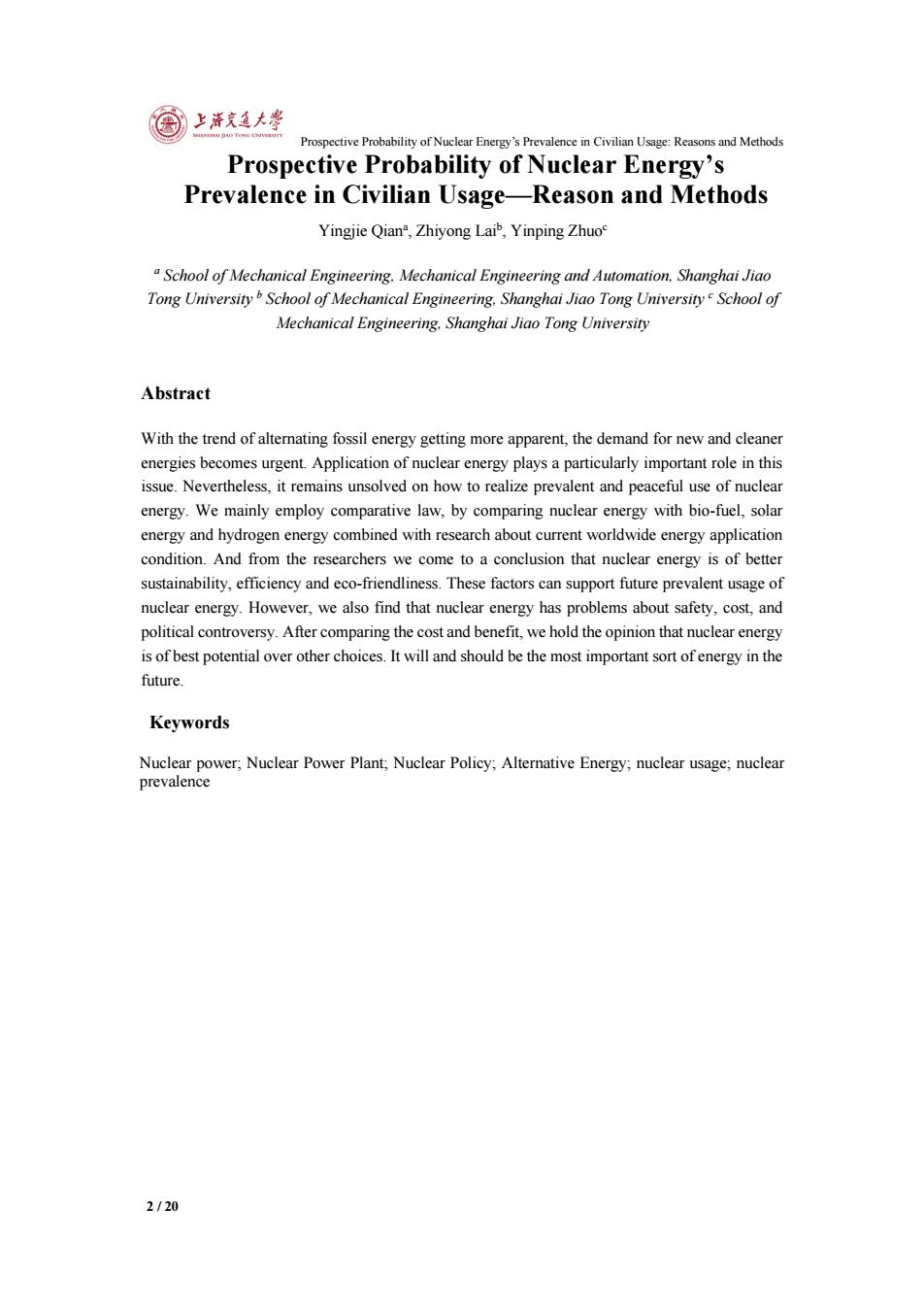
上泽克通大粤 Prospective Probability of Nuclear Energy's Prevalence in Civilian Usage:Reasons and Methods Prospective Probability of Nuclear Energy's Prevalence in Civilian Usage-Reason and Methods Yingjie Qian",Zhiyong Laib,Yinping Zhuo a School of Mechanical Engineering,Mechanical Engineering and Automation.Shanghai Jiao Tong Universityb School of Mechanical Engineering.Shanghai Jiao Tong University School of Mechanical Engineering.Shanghai Jiao Tong University Abstract With the trend of alternating fossil energy getting more apparent,the demand for new and cleaner energies becomes urgent.Application of nuclear energy plays a particularly important role in this issue.Nevertheless,it remains unsolved on how to realize prevalent and peaceful use of nuclear energy.We mainly employ comparative law,by comparing nuclear energy with bio-fuel,solar energy and hydrogen energy combined with research about current worldwide energy application condition.And from the researchers we come to a conclusion that nuclear energy is of better sustainability,efficiency and eco-friendliness.These factors can support future prevalent usage of nuclear energy.However,we also find that nuclear energy has problems about safety,cost,and political controversy.After comparing the cost and benefit,we hold the opinion that nuclear energy is of best potential over other choices.It will and should be the most important sort of energy in the future. Keywords Nuclear power;Nuclear Power Plant;Nuclear Policy;Alternative Energy;nuclear usage;nuclear prevalence 2/20
Prospective Probability of Nuclear Energy’s Prevalence in Civilian Usage: Reasons and Methods 2 / 20 Prospective Probability of Nuclear Energy’s Prevalence in Civilian Usage—Reason and Methods Yingjie Qiana , Zhiyong Laib , Yinping Zhuoc a School of Mechanical Engineering, Mechanical Engineering and Automation, Shanghai Jiao Tong University b School of Mechanical Engineering, Shanghai Jiao Tong University c School of Mechanical Engineering, Shanghai Jiao Tong University Abstract With the trend of alternating fossil energy getting more apparent, the demand for new and cleaner energies becomes urgent. Application of nuclear energy plays a particularly important role in this issue. Nevertheless, it remains unsolved on how to realize prevalent and peaceful use of nuclear energy. We mainly employ comparative law, by comparing nuclear energy with bio-fuel, solar energy and hydrogen energy combined with research about current worldwide energy application condition. And from the researchers we come to a conclusion that nuclear energy is of better sustainability, efficiency and eco-friendliness. These factors can support future prevalent usage of nuclear energy. However, we also find that nuclear energy has problems about safety, cost, and political controversy. After comparing the cost and benefit, we hold the opinion that nuclear energy is of best potential over other choices. It will and should be the most important sort of energy in the future. Keywords Nuclear power; Nuclear Power Plant; Nuclear Policy; Alternative Energy; nuclear usage; nuclear prevalence
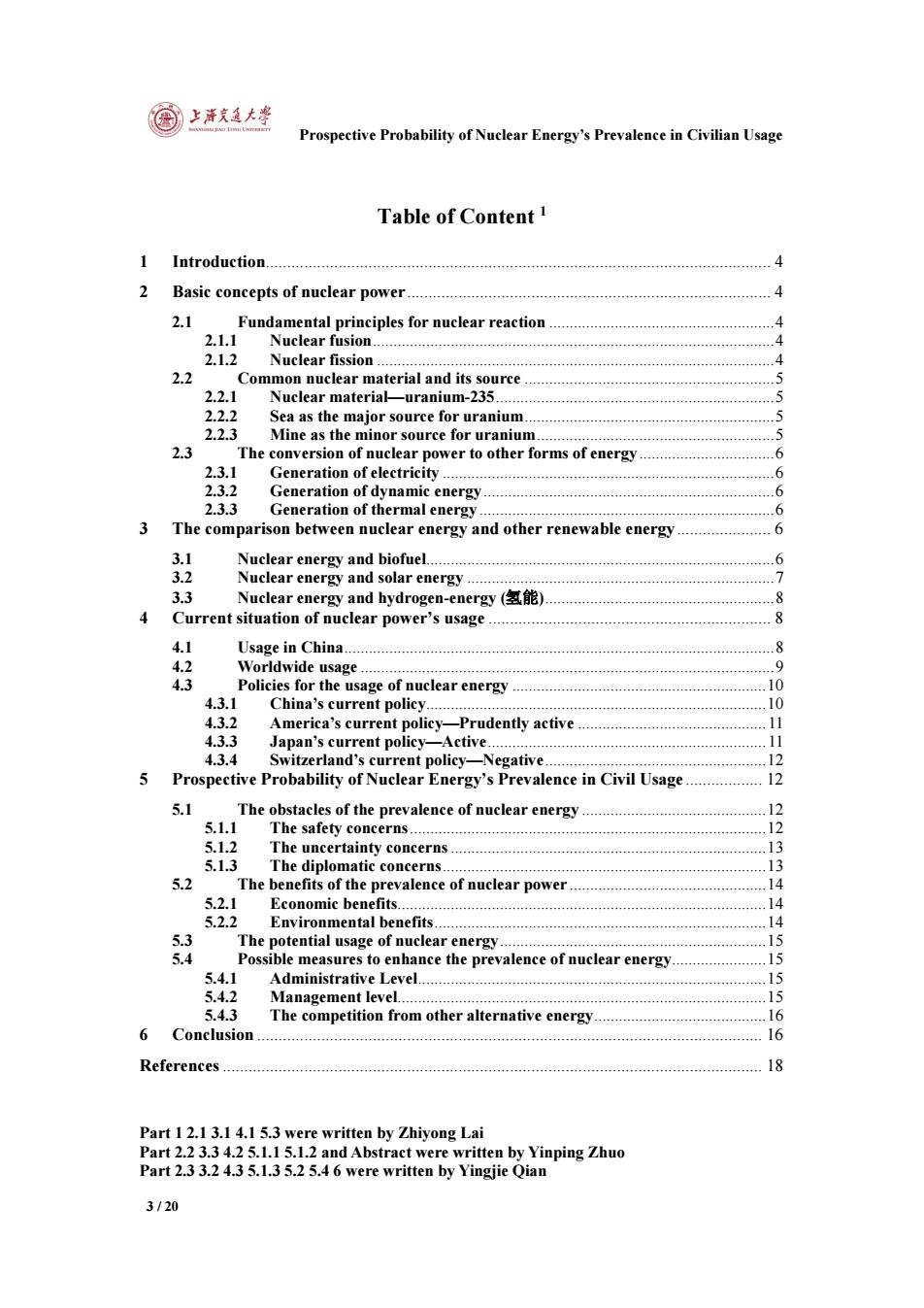
上亥盈大粤 Prospective Probability of Nuclear Energy's Prevalence in Civilian Usage Table of Content 1 2 Basic concepts of nuclear power................ 4 2.1 Fundamental principles for nuclear reaction...4 2.1.1 Nuclear fusion..4 2.1.2 Nuclear fission.......... 4 2.2 Common nuclear material and its source.5 2.2.1 Nuclear material-uranium-235............... .5 2.2.2 Sea as the major source for uranium.5 2.2.3 Mine as the minor source for uranium...... .5 2.3 The conversion of nuclear power to other forms of energy..6 2.3.1 Generation of electricity ........... 6 2.3.2 Generation of dynamic energy6 2.3.3 Generation of thermal energy...... 6 3 The comparison between nuclear energy and other renewable energy......6 3.1 Nuclear energy and biofuel6 3.2 Nuclear energy and solar energy..... 7 3.3 Nuclear energy and hydrogen-energy(氢能) .8 4 Current situation of nuclear power's usage................ .8 4.1 Usage in China.......... .8 4.2 W0rld小wide usage..9 4.3 Policies for the usage of nuclear energy.......... 10 4.3.1 China's current policy.10 4.3.2 America's current policy-Prudently active.......................... 11 4.3.3 Japan's current policy-Active 11 4.3.4 Switzerland's current policy-Negative....... . Prospective Probability of Nuclear Energy's Prevalence in Civil Usage 2 5.1 The obstacles of the prevalence of nuclear energy..12 5.1.1 The safety concerns..12 5.1.2 The uncertainty concerns.13 5.1.3 The diplomatic concerns.... 13 5.2 The benefits of the prevalence of nuclear power............ 1 5.2.1 Economic benefits...... 14 5.2.2 Environmental benefits. 14 5.3 The potential usage of nuclear energy.15 5.4 Possible measures to enhance the prevalence of nuclear energy...........15 5.4.1 Administrative Level..1 5.4.2 Management level............ 15 ””””” 5.4.3 The competition from other alternative energy........................ 16 6 Conclusion 6 References................. 18 Part 1 2.1 3.1 4.1 5.3 were written by Zhiyong Lai Part 2.2 3.3 4.2 5.1.1 5.1.2 and Abstract were written by Yinping Zhuo Part 2.3 3.2 4.3 5.1.3 5.2 5.4 6 were written by Yingjie Qian 3/20
Prospective Probability of Nuclear Energy’s Prevalence in Civilian Usage 3 / 20 Table of Content 1 1 Introduction...................................................................................................................... 4 2 Basic concepts of nuclear power..................................................................................... 4 2.1 Fundamental principles for nuclear reaction .......................................................4 2.1.1 Nuclear fusion..................................................................................................4 2.1.2 Nuclear fission .................................................................................................4 2.2 Common nuclear material and its source .............................................................5 2.2.1 Nuclear material—uranium-235....................................................................5 2.2.2 Sea as the major source for uranium.............................................................5 2.2.3 Mine as the minor source for uranium..........................................................5 2.3 The conversion of nuclear power to other forms of energy.................................6 2.3.1 Generation of electricity .................................................................................6 2.3.2 Generation of dynamic energy.......................................................................6 2.3.3 Generation of thermal energy ........................................................................6 3 The comparison between nuclear energy and other renewable energy...................... 6 3.1 Nuclear energy and biofuel.....................................................................................6 3.2 Nuclear energy and solar energy ...........................................................................7 3.3 Nuclear energy and hydrogen-energy (氢能)........................................................8 4 Current situation of nuclear power’s usage .................................................................. 8 4.1 Usage in China.........................................................................................................8 4.2 Worldwide usage .....................................................................................................9 4.3 Policies for the usage of nuclear energy ..............................................................10 4.3.1 China’s current policy...................................................................................10 4.3.2 America’s current policy—Prudently active ..............................................11 4.3.3 Japan’s current policy—Active....................................................................11 4.3.4 Switzerland’s current policy—Negative......................................................12 5 Prospective Probability of Nuclear Energy’s Prevalence in Civil Usage .................. 12 5.1 The obstacles of the prevalence of nuclear energy .............................................12 5.1.1 The safety concerns.......................................................................................12 5.1.2 The uncertainty concerns.............................................................................13 5.1.3 The diplomatic concerns...............................................................................13 5.2 The benefits of the prevalence of nuclear power ................................................14 5.2.1 Economic benefits..........................................................................................14 5.2.2 Environmental benefits.................................................................................14 5.3 The potential usage of nuclear energy.................................................................15 5.4 Possible measures to enhance the prevalence of nuclear energy.......................15 5.4.1 Administrative Level.....................................................................................15 5.4.2 Management level..........................................................................................15 5.4.3 The competition from other alternative energy..........................................16 6 Conclusion ...................................................................................................................... 16 References.............................................................................................................................. 18 Part 1 2.1 3.1 4.1 5.3 were written by Zhiyong Lai Part 2.2 3.3 4.2 5.1.1 5.1.2 and Abstract were written by Yinping Zhuo Part 2.3 3.2 4.3 5.1.3 5.2 5.4 6 were written by Yingjie Qian
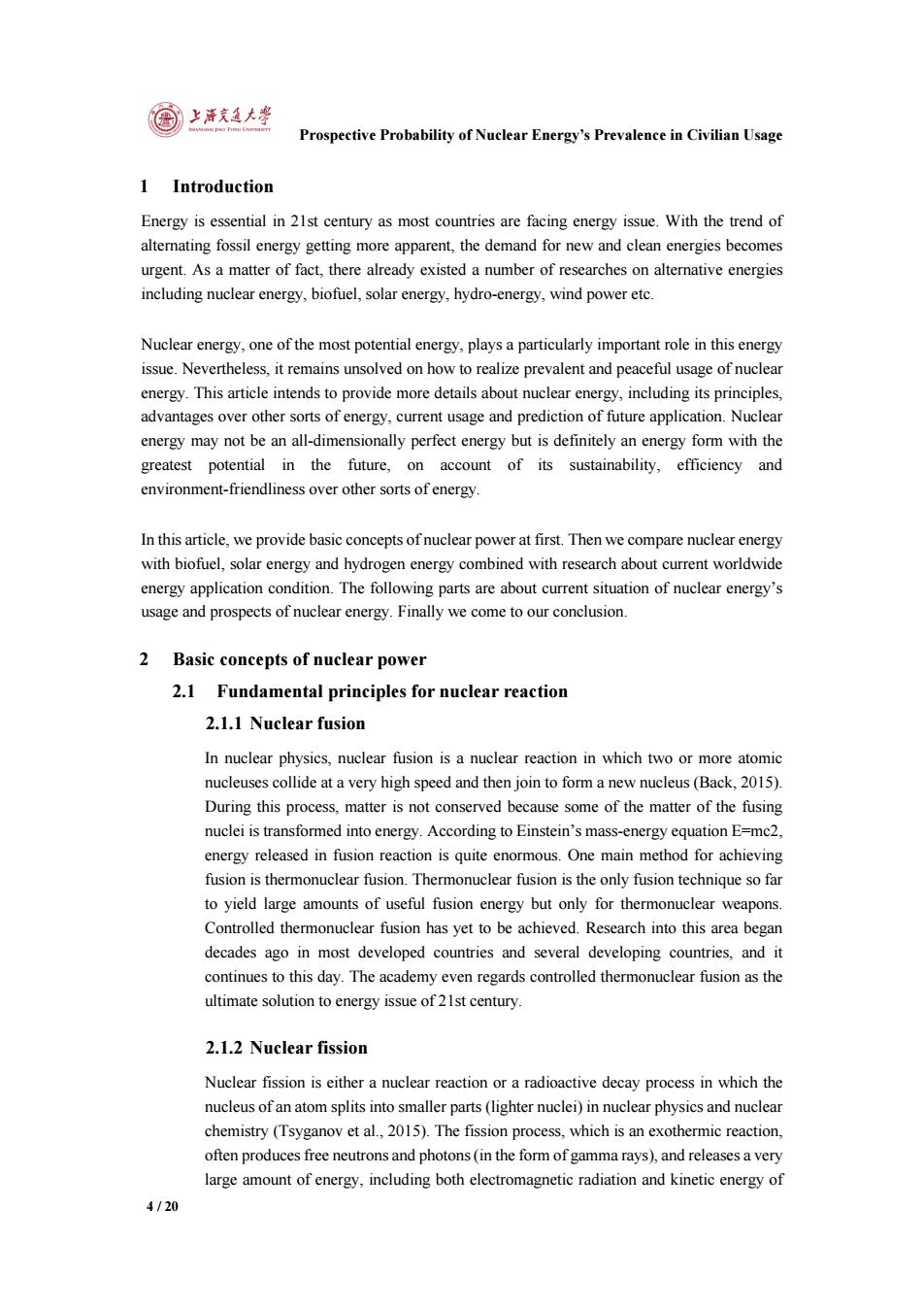
上充益大粤 Prospective Probability of Nuclear Energy's Prevalence in Civilian Usage 1 Introduction Energy is essential in 21st century as most countries are facing energy issue.With the trend of alternating fossil energy getting more apparent,the demand for new and clean energies becomes urgent.As a matter of fact,there already existed a number of researches on alternative energies including nuclear energy,biofuel,solar energy,hydro-energy,wind power etc. Nuclear energy,one of the most potential energy,plays a particularly important role in this energy issue.Nevertheless,it remains unsolved on how to realize prevalent and peaceful usage of nuclear energy.This article intends to provide more details about nuclear energy,including its principles, advantages over other sorts of energy,current usage and prediction of future application.Nuclear energy may not be an all-dimensionally perfect energy but is definitely an energy form with the greatest potential in the future,on account of its sustainability,efficiency and environment-friendliness over other sorts of energy. In this article,we provide basic concepts of nuclear power at first.Then we compare nuclear energy with biofuel,solar energy and hydrogen energy combined with research about current worldwide energy application condition.The following parts are about current situation of nuclear energy's usage and prospects of nuclear energy.Finally we come to our conclusion. 2 Basic concepts of nuclear power 2.1 Fundamental principles for nuclear reaction 2.1.1 Nuclear fusion In nuclear physics,nuclear fusion is a nuclear reaction in which two or more atomic nucleuses collide at a very high speed and then join to form a new nucleus(Back,2015). During this process,matter is not conserved because some of the matter of the fusing nuclei is transformed into energy.According to Einstein's mass-energy equation E=mc2, energy released in fusion reaction is quite enormous.One main method for achieving fusion is thermonuclear fusion.Thermonuclear fusion is the only fusion technique so far to yield large amounts of useful fusion energy but only for thermonuclear weapons. Controlled thermonuclear fusion has yet to be achieved.Research into this area began decades ago in most developed countries and several developing countries,and it continues to this day.The academy even regards controlled thermonuclear fusion as the ultimate solution to energy issue of 21st century. 2.1.2 Nuclear fission Nuclear fission is either a nuclear reaction or a radioactive decay process in which the nucleus of an atom splits into smaller parts (lighter nuclei)in nuclear physics and nuclear chemistry(Tsyganov et al.,2015).The fission process,which is an exothermic reaction, often produces free neutrons and photons(in the form of gamma rays),and releases a very large amount of energy,including both electromagnetic radiation and kinetic energy of 4/20
Prospective Probability of Nuclear Energy’s Prevalence in Civilian Usage 4 / 20 1 Introduction Energy is essential in 21st century as most countries are facing energy issue. With the trend of alternating fossil energy getting more apparent, the demand for new and clean energies becomes urgent. As a matter of fact, there already existed a number of researches on alternative energies including nuclear energy, biofuel, solar energy, hydro-energy, wind power etc. Nuclear energy, one of the most potential energy, plays a particularly important role in this energy issue. Nevertheless, it remains unsolved on how to realize prevalent and peaceful usage of nuclear energy. This article intends to provide more details about nuclear energy, including its principles, advantages over other sorts of energy, current usage and prediction of future application. Nuclear energy may not be an all-dimensionally perfect energy but is definitely an energy form with the greatest potential in the future, on account of its sustainability, efficiency and environment-friendliness over other sorts of energy. In this article, we provide basic concepts of nuclear power at first. Then we compare nuclear energy with biofuel, solar energy and hydrogen energy combined with research about current worldwide energy application condition. The following parts are about current situation of nuclear energy’s usage and prospects of nuclear energy. Finally we come to our conclusion. 2 Basic concepts of nuclear power 2.1 Fundamental principles for nuclear reaction 2.1.1 Nuclear fusion In nuclear physics, nuclear fusion is a nuclear reaction in which two or more atomic nucleuses collide at a very high speed and then join to form a new nucleus (Back, 2015). During this process, matter is not conserved because some of the matter of the fusing nuclei is transformed into energy. According to Einstein’s mass-energy equation E=mc2, energy released in fusion reaction is quite enormous. One main method for achieving fusion is thermonuclear fusion. Thermonuclear fusion is the only fusion technique so far to yield large amounts of useful fusion energy but only for thermonuclear weapons. Controlled thermonuclear fusion has yet to be achieved. Research into this area began decades ago in most developed countries and several developing countries, and it continues to this day. The academy even regards controlled thermonuclear fusion as the ultimate solution to energy issue of 21st century. 2.1.2 Nuclear fission Nuclear fission is either a nuclear reaction or a radioactive decay process in which the nucleus of an atom splits into smaller parts (lighter nuclei) in nuclear physics and nuclear chemistry (Tsyganov et al., 2015). The fission process, which is an exothermic reaction, often produces free neutrons and photons (in the form of gamma rays), and releases a very large amount of energy, including both electromagnetic radiation and kinetic energy of
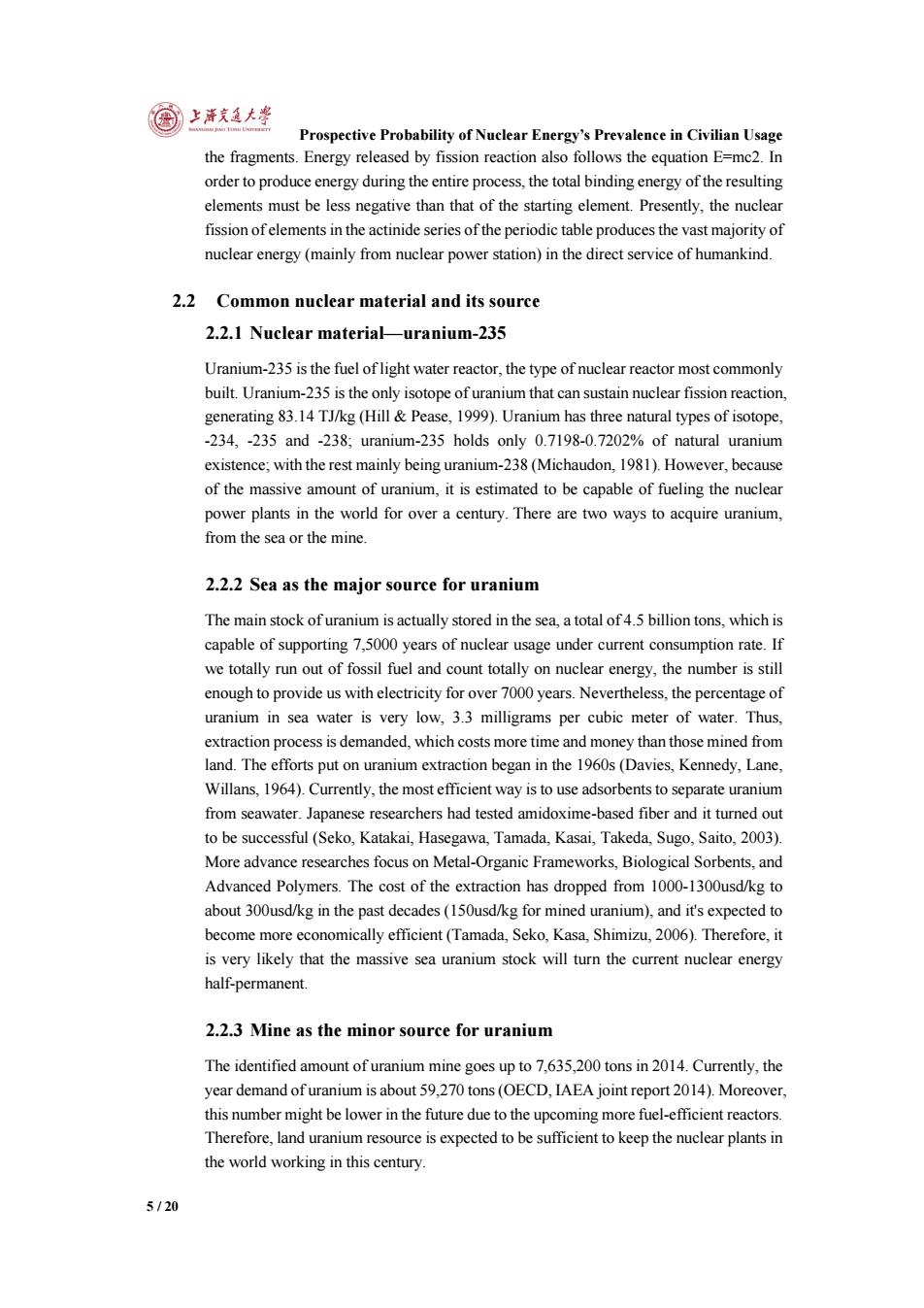
上充益大粤 Prospective Probability of Nuclear Energy's Prevalence in Civilian Usage the fragments.Energy released by fission reaction also follows the equation E=mc2.In order to produce energy during the entire process,the total binding energy of the resulting elements must be less negative than that of the starting element.Presently,the nuclear fission ofelements in the actinide series of the periodic table produces the vast majority of nuclear energy(mainly from nuclear power station)in the direct service of humankind. 2.2 Common nuclear material and its source 2.2.1 Nuclear material-uranium-235 Uranium-235 is the fuel of light water reactor,the type of nuclear reactor most commonly built.Uranium-235 is the only isotope of uranium that can sustain nuclear fission reaction, generating 83.14 TJ/kg (Hill Pease,1999).Uranium has three natural types of isotope, -234,-235 and -238;uranium-235 holds only 0.7198-0.7202%of natural uranium existence;with the rest mainly being uranium-238(Michaudon,1981).However,because of the massive amount of uranium,it is estimated to be capable of fueling the nuclear power plants in the world for over a century.There are two ways to acquire uranium, from the sea or the mine. 2.2.2 Sea as the major source for uranium The main stock of uranium is actually stored in the sea,a total of 4.5 billion tons,which is capable of supporting 7,5000 years of nuclear usage under current consumption rate.If we totally run out of fossil fuel and count totally on nuclear energy,the number is still enough to provide us with electricity for over 7000 years.Nevertheless,the percentage of uranium in sea water is very low,3.3 milligrams per cubic meter of water.Thus, extraction process is demanded,which costs more time and money than those mined from land.The efforts put on uranium extraction began in the 1960s(Davies,Kennedy,Lane, Willans,1964).Currently,the most efficient way is to use adsorbents to separate uranium from seawater.Japanese researchers had tested amidoxime-based fiber and it turned out to be successful(Seko,Katakai,Hasegawa,Tamada,Kasai,Takeda,Sugo,Saito,2003). More advance researches focus on Metal-Organic Frameworks.Biological Sorbents.and Advanced Polymers.The cost of the extraction has dropped from 1000-1300usd/kg to about 300usd/kg in the past decades (150usd/kg for mined uranium).and it's expected to become more economically efficient(Tamada,Seko,Kasa,Shimizu,2006).Therefore,it is very likely that the massive sea uranium stock will turn the current nuclear energy half-permanent. 2.2.3 Mine as the minor source for uranium The identified amount of uranium mine goes up to 7,635,200 tons in 2014.Currently,the year demand of uranium is about 59,270 tons(OECD,IAEA joint report 2014).Moreover, this number might be lower in the future due to the upcoming more fuel-efficient reactors. Therefore,land uranium resource is expected to be sufficient to keep the nuclear plants in the world working in this century. 5/20
Prospective Probability of Nuclear Energy’s Prevalence in Civilian Usage 5 / 20 the fragments. Energy released by fission reaction also follows the equation E=mc2. In order to produce energy during the entire process, the total binding energy of the resulting elements must be less negative than that of the starting element. Presently, the nuclear fission of elements in the actinide series of the periodic table produces the vast majority of nuclear energy (mainly from nuclear power station) in the direct service of humankind. 2.2 Common nuclear material and its source 2.2.1 Nuclear material—uranium-235 Uranium-235 is the fuel of light water reactor, the type of nuclear reactor most commonly built. Uranium-235 is the only isotope of uranium that can sustain nuclear fission reaction, generating 83.14 TJ/kg (Hill & Pease, 1999). Uranium has three natural types of isotope, -234, -235 and -238; uranium-235 holds only 0.7198-0.7202% of natural uranium existence; with the rest mainly being uranium-238 (Michaudon, 1981). However, because of the massive amount of uranium, it is estimated to be capable of fueling the nuclear power plants in the world for over a century. There are two ways to acquire uranium, from the sea or the mine. 2.2.2 Sea as the major source for uranium The main stock of uranium is actually stored in the sea, a total of 4.5 billion tons, which is capable of supporting 7,5000 years of nuclear usage under current consumption rate. If we totally run out of fossil fuel and count totally on nuclear energy, the number is still enough to provide us with electricity for over 7000 years. Nevertheless, the percentage of uranium in sea water is very low, 3.3 milligrams per cubic meter of water. Thus, extraction process is demanded, which costs more time and money than those mined from land. The efforts put on uranium extraction began in the 1960s (Davies, Kennedy, Lane, Willans, 1964). Currently, the most efficient way is to use adsorbents to separate uranium from seawater. Japanese researchers had tested amidoxime-based fiber and it turned out to be successful (Seko, Katakai, Hasegawa, Tamada, Kasai, Takeda, Sugo, Saito, 2003). More advance researches focus on Metal-Organic Frameworks, Biological Sorbents, and Advanced Polymers. The cost of the extraction has dropped from 1000-1300usd/kg to about 300usd/kg in the past decades (150usd/kg for mined uranium), and it's expected to become more economically efficient (Tamada, Seko, Kasa, Shimizu, 2006). Therefore, it is very likely that the massive sea uranium stock will turn the current nuclear energy half-permanent. 2.2.3 Mine as the minor source for uranium The identified amount of uranium mine goes up to 7,635,200 tons in 2014. Currently, the year demand of uranium is about 59,270 tons (OECD, IAEA joint report 2014). Moreover, this number might be lower in the future due to the upcoming more fuel-efficient reactors. Therefore, land uranium resource is expected to be sufficient to keep the nuclear plants in the world working in this century